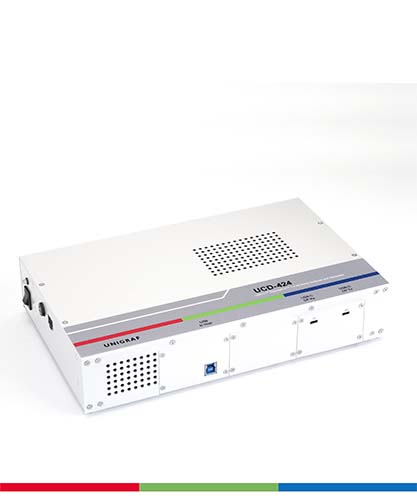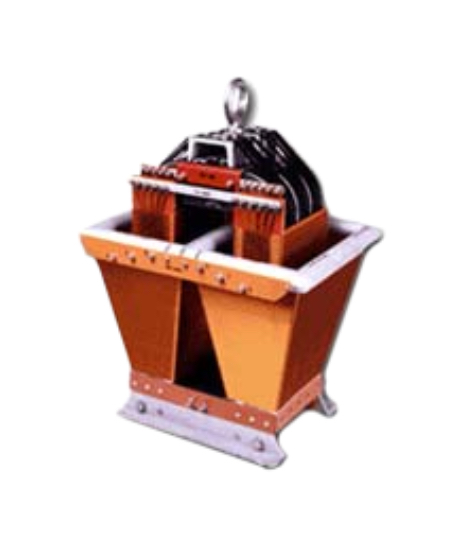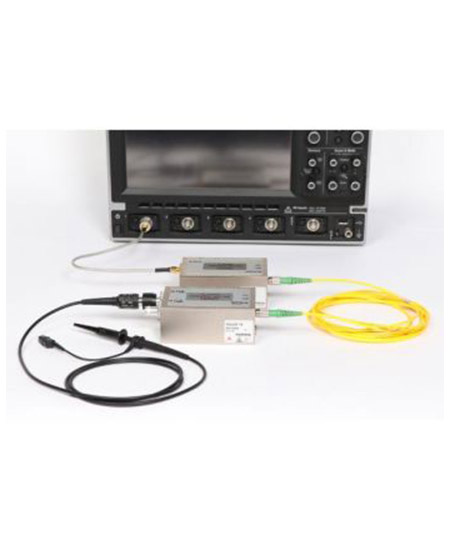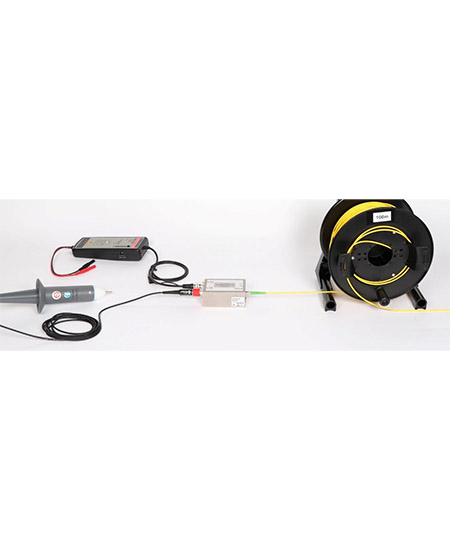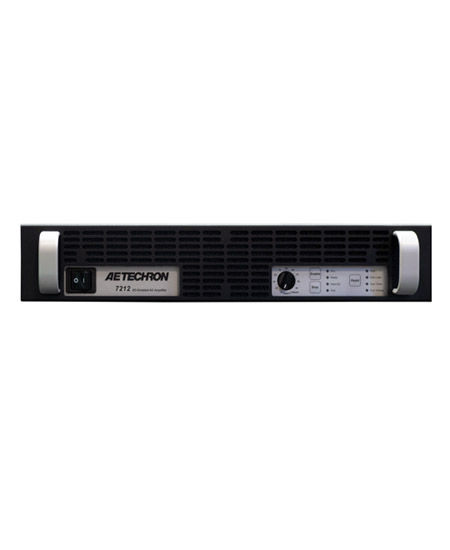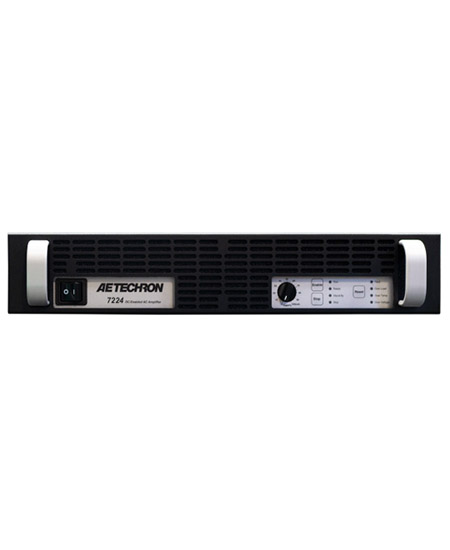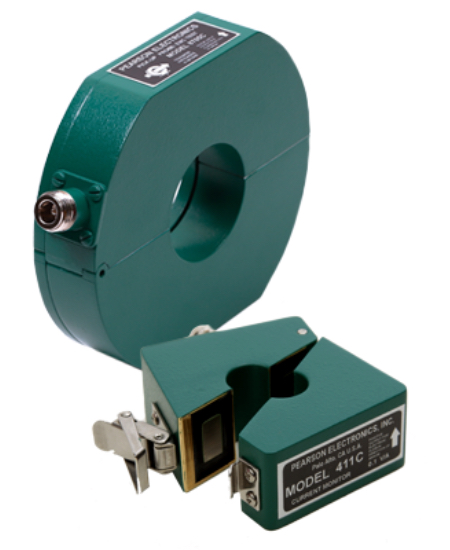Unigraf UCD-424 • USB-C DP Alt Mode 8K Video Generator & Analyzer
USB-C DisplayPort Alt Mode Test Unit DP 1.4a, HBR3 & PD 3.0
- 8K and 4K Reference Sink & Source
- DP 1.4a Link Layer CTS for Sinks & Sources
- HDCP 2.3 CTS for Transmitters & Receivers
- DP 1.4a features:
* Up to HBR3 simultaneous input and output in one unit
* DSC Sink & Source with off-line encoding and decoding
* FEC and LTTPR support
* MST support (4 streams) - USB-C v1.3 with Power Delivery 3.0
* DP Alt Mode
* Capable to sink & source 9V@3A
* PD Role swaps supported - USB3.2Gen2 (10Gbit/s) bypass between test interfaces
- HDCP 1.3 and HDCP 2.3 support
Introducing the Unigraf UCD-424 • USB-C DP Alt Mode 8K Video Generator & Analyzer
UCD-424 is an 8K Reference Sink, Source and Branch for verifying DisplayPort™ Alt Mode over USB-C up to 8K@30 Hz (8K@60 Hz with DSC) and 4K@120 Hz video modes with HBR3 max bit rate capability. It features USB-C v1.3 input and output with Power Delivery 3.0. The unit also supports MST (4 streams), Forward Error Correction (FEC), Display Stream Compression (DSC), and Link-Training Tunable PHY Repeater (LTTPR). UCD-424 also supports DP 1.4a Link Layer, DSC and HDCP 2.3 compliance testing.
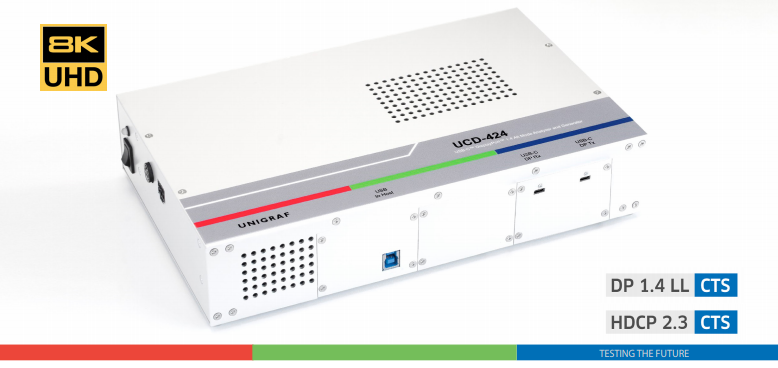
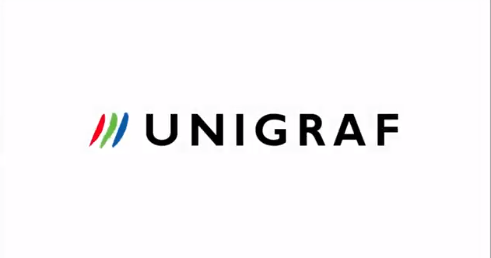
Key Features
Test 8K
UCD-424 is interface test unit for verifying DisplayPort™ Alternate mode over USB-C™ up to 8K@30 Hz and 4K@120 Hz video modes. The device gives you control for USB-C data and power roles. It is a flexible and robust tool either via a GUI on a laboratory desktop or via automated functional tests. The associated software provides the user access to the vital parameters and controls needed when evaluating the various functions of the interface.
For R&D and Test Automation
UCD-424 supports both hands-on debugging and running extended automated test sequences. UCD Console GUI is a preview and test application for desktop use. Each interface function has a wellstructured dialog for superior at-a-glance viewability.
Unigraf TSI is a test software API that provides the system integrator a fast and reliable way for ensuring the functionality of the tested equipment.
Validation Tool
UCD-424 is a Compliance Test Tool for testing DisplayPort 1.4a Link Layer CTS on Sinks and Sources. The device is also capable of HDCP 2.2 and 2.3 CTS on Transmitters and Receivers. The unit supports FEC, DSC Sink and LTTPR. Please contact Unigraf for details.
Key Benefits
Reliable Compliance Testing Tool
DisplayPort 1.4a Link Layer Compliance Testing
Just like any other DisplayPort device, devices with USB-C DisplayPort Alternate Mode capability need to be tested for DisplayPort compliance. UCD-424 supports DP 1.4a Link Layer CTS including DSC testing on Sinks, Sources and Branches. Certification from VESA on the Link Layer CTS tests for UCD-424 is pending.
HDCP 2.3 Compliance Testing
VESA requires HDCP testing as part of the DisplayPort testing requirement for certification. If a DisplayPort receiver or transmitter supports HDCP (as reported in the product CDF) it shall be tested as part of the certification requirements for obtaining the DisplayPort Logo. (Source: VESA)
UCD-424 supports HDCP 2.3 compliance testing on USB-C DP Alt Mode Transmitters, Receivers and Repeaters. The official approval of HDCP 2.3 CTS testing for UCD-424 from DCP is pending.
E-learning center: HDCP 2.3 CTS Testing
Unique Features
DisplayPort Entry From Any Role
UCD-424 can enter to DP Alt Mode with any DP Alt Mode partner. Enter DP Alt Mode from any state and controls to swap roles is possible.
UCD Console GUI:
The UCD Console GUI is the dedicated software that enables users to access the test features of the UCD-424 and is supported for Windows, macOS, and Linux. The software provides the user with a flexible way of navigating between the interface based roles of the device and functionalities of each role. The UCD Console features a preview window for the received video and audio, while also monitoring the controls of the link parameters and built-in pattern generator in UCD-424. Users can also have access to an EDID editor and control of the HDCP function.
E-learning center: UDC Console GUI
LTTPR (Link Training Tunable PHY Repeaters):
Default Tests in UCD-424
UCD-424 device is delivered with UCD Console and TSI (Test System Interface) SDK (System Development Kit) for Type-C Sinks and Sources. Please, refer to the table below to see the default tests provided with UCD Console and TSI SDK.
Note: HDCP 2.3 Support is also delivered with the UCD-424 device.
For Type-C DP Sink
| Category | Feature |
|---|---|
| USB-C Modes | USB Data Role status |
| USB Data Role control | |
| USB-C Power Role status | |
| USB-C Power Role control | |
| Event Logger | |
| Power Delivery protocol monitoring | |
| USB-C Vbus / CC / Vconn voltage & current monitoring | |
| DP Alt Mode | USB-C DP Alt Mode status |
| USB-C DP Alt Mode control | |
| DP AUX Analyzer | |
| EDID read and write | |
| DCPD read and write | |
| Event Log | |
| DP Alt Mode Reference Sink | DP Link Status Information |
| DP Alt Mode capture, preview and saving | |
| Link and CRC tests for Source DUT | |
| DP Alt Mode Reference Source | DP Link Status Information |
| Video Pattern Generator with fixed patterns and timings | |
| Audio generator | |
| Monitor SDP | |
| Testing HDCP | HDCP preview up to 2.3 |
| HDCP status monitor and control up to HDCP 2.3 | |
| HDCP 2.3 Key Test support |
For Type-C DP Source
| Category | Feature |
|---|---|
| USB-C Modes | USB Data Role status |
| USB Data Role control | |
| USB-C Power Role status | |
| USB-C Power Role control | |
| Event Logger | |
| Power Delivery protocol monitoring | |
| USB-C Vbus / CC / Vconn voltage & current monitoring | |
| DP Alt Mode | USB-C DP Alt Mode status |
| USB-C DP Alt Mode control | |
| DP AUX Analyzer | |
| EDID read and write | |
| DCPD read and write | |
| Event Log | |
| DP Alt Mode Reference Sink | DP Link Status Information |
| DP Alt Mode capture, preview and saving | |
| DP Alt Mode Reference Source | DP Link Status Information |
| Control the Downstream Link | |
| Video Pattern Generator with fixed patterns and timings | |
| Video Pattern Generator with custom patterns and timings | |
| Audio generator | |
| Testing HDCP | HDCP preview up to 2.3 |
| HDCP status monitor and control up to HDCP 2.3 | |
| HDCP 2.3 Key Test support |
Highlights
-
8K and 4K Reference Sink & Source
-
DP 1.4a Link Layer CTS for Sinks & Sources
-
HDCP 2.3 CTS for Transmitters & Receivers
-
DP 1.4a Features:
-
Up to HBR3 simultaneous input and output in one unit
-
DSC Sink & Source with off-line encoding and decoding
-
FEC and LTTPR support
-
MST support (4 streams)
-
-
USB-C v1.3 with Power Delivery 3.0
-
DP Alt Mode
-
Capable to Sink & Source 9V@3A
-
PD Role swaps supported
-
-
USB3.2Gen2 (10Gbit/s) bypass between test interfaces
-
HDCP 1.3 and HDCP 2.3 support
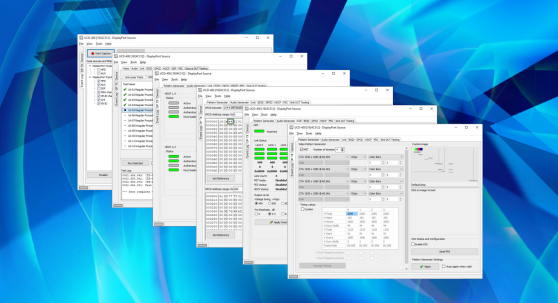
Trust the Experts at ACA TMetrix Inc.
ACA TMetrix Inc. is a leading Canadian distributor of test and measurement instruments and design tools. For over 55 years we have provided products manufactured by the world’s leading instrument manufacturers. Leading Distributor of Design Tools and Test Equipment in Canada.
Specifications
| Input | USB-C & PD 3.0 compliant DRP port with DP 1.4a Alt Mode Receiver capability (8K@30 Hz / 4K@120Hz) |
| Output | USB-C & PD 3.0 compliant DRP port with DP 1.4a Alt Mode Transmitter capability (8K@30 Hz / 4K@120 Hz) |
| USB Pass Through | USB3.2 Gen2 data pass-through between test interfaces |
| Vbus Power | Up to 3A@9V input and ouput |
| Content Protection | HDCP 1.3, 2.2, and 2.3 |
| DSC Capability | DSC 1.2a sink with off-line decompression DSC 1.2a source using pre-compressed content Support RGB / YCbCr up to 12 bits per component 24 slices, max with 7680 pixels Up to 8K@60 Hz |
| Additional features | MST*, FEC*, LTTPR* DP 1.4a LL CTS, DP DSC CTS HDCP 2.3 CTS |
| Computer Interface | USB 3.0 |
| Operating System | Windows 10, 8 and 7 macOS*, Linux* and Asterix* available Q2/20 |
| Software | UCD Console GUI TSI API with interface specific Test Sets |
| Power Input | +12 Vdc (AC/DC converter included) |
| Module Size | 310 x 190 x 61 mm |
| Weight | 1.3 kg w/o power supply |
Datasheet



